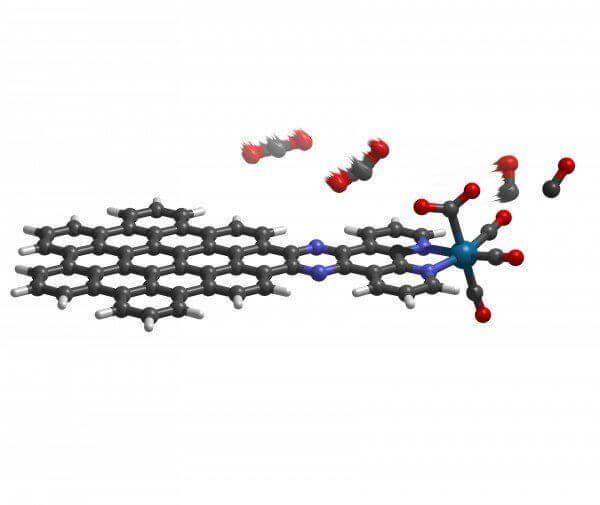511
Developed molecular "sheet" for collecting and storing solar energy
An international group of scientists under the direction of chemist Liang-Shi Li from Indiana University have created molecules that mimic the function of leaves in plants. Development allows to collect and store solar energy without using solar panels.
Molecule uses light and electricity to convert carbon dioxide to carbon monoxide — a carbon-neutral fuel source. The method, published in the Journal of the American Chemical Society, will allow the conversion as efficiently as possible at minimum cost of energy.

"If you get a quite effective molecule for such a reaction, it will be no cost to produce energy and store it in the form of fuel," said Lee.
Chemists have managed to achieve high efficiency thanks to nanographene. The researchers used a molecule, which is nanographene-rhenium complex, connected to the organic compound with biperidenom.

Ben Noffke and Richard Schaugaard, Indiana University
Nanographene performs the role of energy collector that absorbs the sun's energy. And the "atomic engine" from rhenium produces carbon monoxide. According to Lee, bedridinova-metal compounds have long been used to convert carbon dioxide to carbon monoxide with sunlight. But usually such molecules using only a small portion of the spectrum, mainly in the UV range. Chemists designed a molecule absorbs sunlight with a wavelength of 600 nanometers is possible due to the absorbing properties of nanographene.
"Carbon monoxide is considered the most important element in various industrial processes. It also allows you to store energy in the form of carbon neutral fuel. When the production of carbon in the atmosphere is not allocated. And solar energy used to produce it, gets a second life," says Lee.

The researchers plan to increase the lifetime of the molecule and preserve its functionality not only in liquid form because solid catalysts are easier to use. Also chemists are going to replace the rare element rhenium in manganese — more affordable and accessible metal.
Recently, scientists from the National laboratories of Lawrence Berkeley and the California Institute of technology have created a new method of obtaining of catalysts for production of solar fuel that can replace coal, oil and other fossil fuels. published
P. S. And remember, only by changing their consumption — together we change the world! ©
Source: hightech.fm/2017/03/09/molecular_leaf
Molecule uses light and electricity to convert carbon dioxide to carbon monoxide — a carbon-neutral fuel source. The method, published in the Journal of the American Chemical Society, will allow the conversion as efficiently as possible at minimum cost of energy.

"If you get a quite effective molecule for such a reaction, it will be no cost to produce energy and store it in the form of fuel," said Lee.
Chemists have managed to achieve high efficiency thanks to nanographene. The researchers used a molecule, which is nanographene-rhenium complex, connected to the organic compound with biperidenom.

Ben Noffke and Richard Schaugaard, Indiana University
Nanographene performs the role of energy collector that absorbs the sun's energy. And the "atomic engine" from rhenium produces carbon monoxide. According to Lee, bedridinova-metal compounds have long been used to convert carbon dioxide to carbon monoxide with sunlight. But usually such molecules using only a small portion of the spectrum, mainly in the UV range. Chemists designed a molecule absorbs sunlight with a wavelength of 600 nanometers is possible due to the absorbing properties of nanographene.
"Carbon monoxide is considered the most important element in various industrial processes. It also allows you to store energy in the form of carbon neutral fuel. When the production of carbon in the atmosphere is not allocated. And solar energy used to produce it, gets a second life," says Lee.

The researchers plan to increase the lifetime of the molecule and preserve its functionality not only in liquid form because solid catalysts are easier to use. Also chemists are going to replace the rare element rhenium in manganese — more affordable and accessible metal.
Recently, scientists from the National laboratories of Lawrence Berkeley and the California Institute of technology have created a new method of obtaining of catalysts for production of solar fuel that can replace coal, oil and other fossil fuels. published
P. S. And remember, only by changing their consumption — together we change the world! ©
Source: hightech.fm/2017/03/09/molecular_leaf
Gratis X1 will be the first production stand-up jet ski on electric
Orders of love between a man and a woman by Bert Hellinger
























